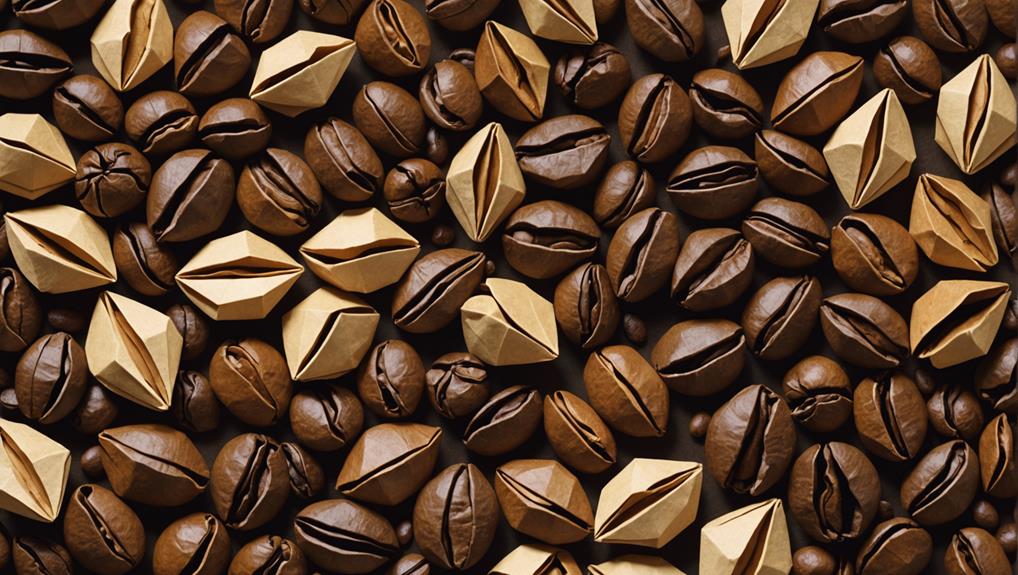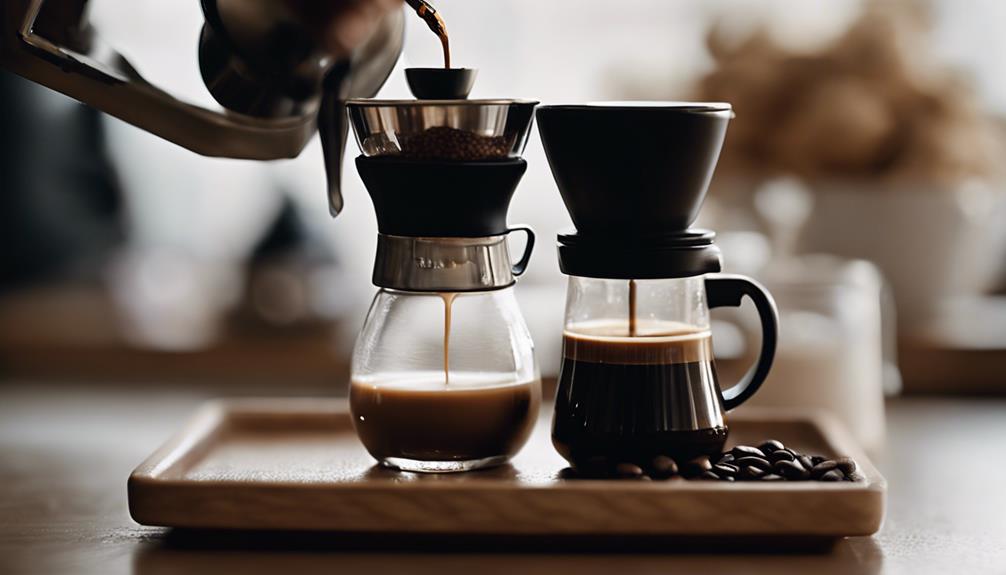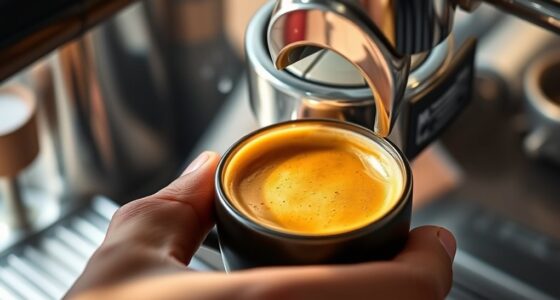Espresso is less bitter than regular coffee due to its distinctive brewing process. The high pressure and short extraction time of espresso result in a smoother taste. When using darker roasts and a fine grind, espresso provides flavor without an overwhelming bitterness. Its smaller serving size delivers a strong yet less bitter experience. It’s important to note that the brewing time significantly affects bitterness in both coffee and espresso. Over-extraction can increase bitterness. If you want to learn more about the variations between espresso and coffee, you can explore further insights on the factors influencing bitterness, the role of acidity, methods to reduce bitterness, and how tasting notes can indicate bitterness levels in espresso.
Key Takeaways
- Espresso's high pressure, short extraction time, and fine grind result in less bitterness.
- Darker roasts in espresso enhance flavor without increasing bitterness levels.
- The concentrated nature of espresso offers a smoother taste than drip coffee.
- Bean type influences bitterness; Arabica beans in espresso are less bitter than Robusta beans.
- Overall, espresso is known to be less bitter than drip coffee due to its unique brewing process.
Espresso Vs Coffee: Bitterness Comparison
Moreover, when comparing the bitterness of espresso and coffee, espresso generally emerges as the less bitter option due to its unique brewing process and concentrated flavors. Espresso machines, with their high pressure and short extraction time, efficiently extract flavors from the coffee grounds, resulting in a smoother taste with less bitterness.
The intense pressure used in an espresso machine helps in extracting the coffee essence without drawing out excessive bitterness. Additionally, espresso beans are often roasted darker than coffee beans, which can enhance the richness of the flavor but not necessarily increase bitterness. The fine grind size of espresso grounds also contributes to a more balanced extraction, reducing the likelihood of a bitter taste compared to coarser coffee grinds.
Moreover, the smaller serving size of espresso allows for a more concentrated flavor profile, offering an intense yet less bitter taste experience than a larger cup of coffee.
Factors Affecting Bitterness in Espresso

When it comes to the bitterness of espresso, factors like bean roasting levels and brewing time play important roles.
The level of roast your beans have undergone can greatly impact the bitterness of your shot.
Additionally, how long you brew your espresso can also affect its overall bitterness profile.
Bean Roasting Levels
Bean roasting levels heavily influence the bitterness experienced in espresso. Darker roasts typically result in a more pronounced bitter taste compared to lighter roasts. Darker roasted coffee beans undergo longer roasting times, leading to the development of bitter compounds that contribute to the intense flavor profile often associated with espresso.
On the other hand, lighter roasts are roasted for shorter durations, preserving more of the bean's natural flavors and resulting in a smoother, less bitter taste in the brewed espresso. The degree of roasting has a substantial impact on the overall taste perception of espresso. Darker roasts impart a bold and bitter essence, while lighter roasts offer a milder and more nuanced flavor profile.
Opting for lighter roasted coffee beans can be a strategic choice for those seeking to minimize the bitterness in their espresso. The shorter roasting times help retain the beans' inherent characteristics and result in a more balanced and enjoyable cup of coffee.
Brewing Time Factors
Achieving the ideal balance in your espresso's flavor profile heavily relies on monitoring the brewing time and its associated factors. When it comes to the bitterness of espresso, brewing time plays a significant role. Over-extraction due to a prolonged brewing time can intensify the bitterness of your espresso. On the other hand, under-extraction from a short brewing time can result in a sour taste, impacting the overall flavor negatively. To help you understand how brewing time affects the bitterness of your espresso, consider the table below:
| Factors Affecting Brewing Time | Impact on Espresso Bitterness |
|---|---|
| Prolonged brewing time | Increased bitterness |
| Short brewing time | Sour taste |
| Optimal extraction time | Well-balanced flavor profile |
Brewing Process Impact on Bitterness
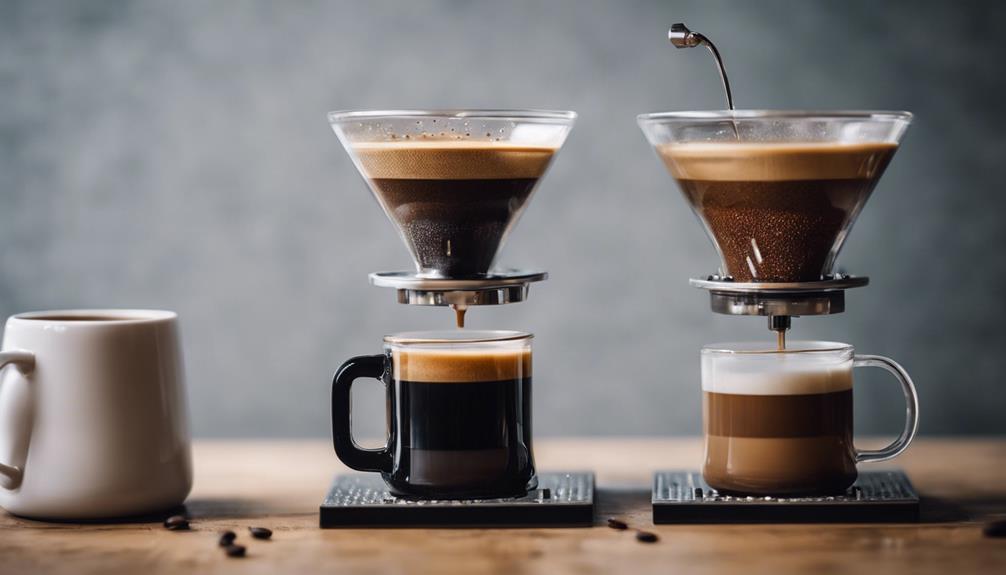
When exploring the impact of the brewing process on bitterness in espresso, it's vital to take into account the roasting levels and extraction time.
The level of roasting can influence the bitterness profile, while the extraction time plays a fundamental role in determining the intensity of flavors.
Understanding how these factors interact during the brewing process can help you appreciate the nuanced balance of bitterness in a well-crafted espresso shot.
Roasting Levels Impact
Roasting levels greatly impact the bitterness experienced in both espresso and coffee. When it comes to coffee beans, the degree of roasting plays a significant role in determining the level of bitterness in your cup.
Lighter roasts, known for their bright and acidic profiles with fruity undertones, tend to offer a less bitter taste compared to their darker counterparts. On the other hand, darker roasts undergo longer roasting times, leading to the caramelization of sugars and the development of bold, smoky flavors that can intensify bitterness.
Understanding the nuances of roasting levels can help you tailor your coffee experience to suit your preferences. Whether you prefer a milder, more nuanced flavor profile or enjoy the robust intensity of a darker roast, selecting the right roasting level is key.
Experimenting with different roasts and brewing methods allows you to fine-tune the bitterness levels in your espresso or coffee, ensuring a satisfying and personalized cup every time.
Extraction Time Influence
Control the extraction time to directly influence the bitterness level in both espresso and coffee. When it comes to the bitter taste in your cup, the time taken to extract the flavors plays a significant role. Understanding how extraction time impacts bitterness can help you tailor your brewing process to suit your taste preferences.
Here are some key points to take into account:
- Espresso's Quick Extraction: The short 25-30 second extraction time for espresso results in a less bitter taste compared to coffee.
- Bitter Compound Extraction: Shorter extraction times limit the extraction of bitter compounds, keeping the overall bitterness in check.
- Longer Extraction for Coffee: Coffee's longer brewing times allow more bitter compounds to be extracted, intensifying the bitterness in the brew.
Bitterness Perception in Coffee Varieties
To fully appreciate the nuances of bitterness in different coffee varieties, consider exploring how taste profiles vary across brewing methods. Bitter taste perception in coffee can be influenced by factors such as bean type and roast level. Different coffee varieties, from Arabica to Robusta beans, can exhibit varying levels of bitterness. Here is a comparison table showcasing the bitterness perception in different coffee varieties based on bean type:
| Bean Type | Bitterness Level |
|---|---|
| Arabica | Low |
| Robusta | High |
| Liberica | Medium |
| Excelsa | Medium-High |
| Maragogipe | Low-Medium |
Understanding the bitterness levels associated with different bean types can guide your coffee selection based on your preference for bitterness intensity. Experimenting with various coffee varieties can help you discover the perfect balance of bitterness and other flavor attributes to suit your taste buds.
Acidity Vs Bitterness in Espresso
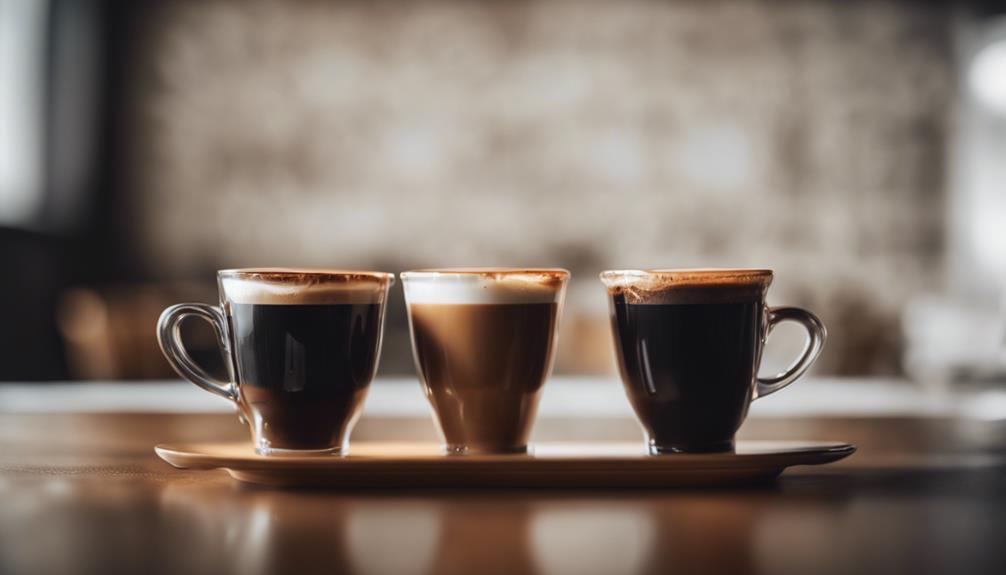
Exploring the differences between acidity and bitterness in espresso reveals how the shorter extraction time contributes to a balanced flavor profile.
When it comes to your espresso shot, understanding how acidity interacts with bitterness can enhance your appreciation of the intricate nuances in coffee flavor.
- Acidity Balances Bitterness: The acidity in espresso can counteract any potential bitterness, creating a harmonious and multi-dimensional taste experience.
- Rich and Smooth Texture: Properly brewed espresso should offer a velvety texture with a subtle hint of bitterness that complements the overall richness of the coffee flavor.
- Intense Flavor Experience: The concentrated nature of espresso shots allows for a more pronounced flavor profile, where bitterness serves as a supporting element rather than the dominant taste.
In essence, the acidity in espresso plays an important role in balancing out bitterness, resulting in a more refined and enjoyable coffee experience that showcases the complexity of flavors within each carefully crafted espresso shot.
Bitterness Mitigation Techniques in Espresso

Using high-quality espresso beans can greatly contribute to reducing bitterness in your espresso shots. Additionally, mastering certain techniques can further enhance the overall taste profile of your espresso. By adjusting variables such as grind size, extraction time, and brewing temperature, you can tailor your espresso to suit your taste buds and make coffee that is less bitter. Below is a table outlining some bitterness mitigation techniques you can employ:
| Technique | Description | Impact on Bitterness |
|---|---|---|
| Selecting Quality Beans | Opt for specialty blends with lower Robusta content and carefully selected Arabica beans. | Decreases bitterness |
| Ensuring Correct Extraction | Maintain correct extraction techniques to prevent over-extraction, which can lead to bitterness. | Balances flavors |
| Adjusting Grind Size | Finer grind can increase extraction efficiency, while coarser grind can reduce bitterness. | Controls bitterness |
| Monitoring Brewing Temperature | Maintaining the best temperature can prevent burnt flavors that contribute to bitterness. | Improves overall taste |
Tasting Notes: Bitterness in Espresso

When tasting espresso, bitterness plays an important role in defining its intense and complex flavor profile. Bitter substances are key components that contribute to the distinctive taste of a perfect espresso.
Here are three essential points to keep in mind when exploring bitterness in espresso:
- Bitterness in espresso adds depth and complexity to its flavor profile, enhancing the overall tasting experience.
- Achieving the right balance of bitterness in espresso is necessary, as it complements the sweetness, acidity, and other flavor notes present in the brew.
- The perception of bitterness in espresso can vary among individuals, influenced by personal preferences and the quality of the coffee beans used in the extraction process.
Understanding how bitterness interacts with other taste elements is crucial for appreciating the unique characteristics of espresso and enjoying a well-crafted cup of this beloved caffeinated beverage.
Bitterness Levels in Espresso Roasts
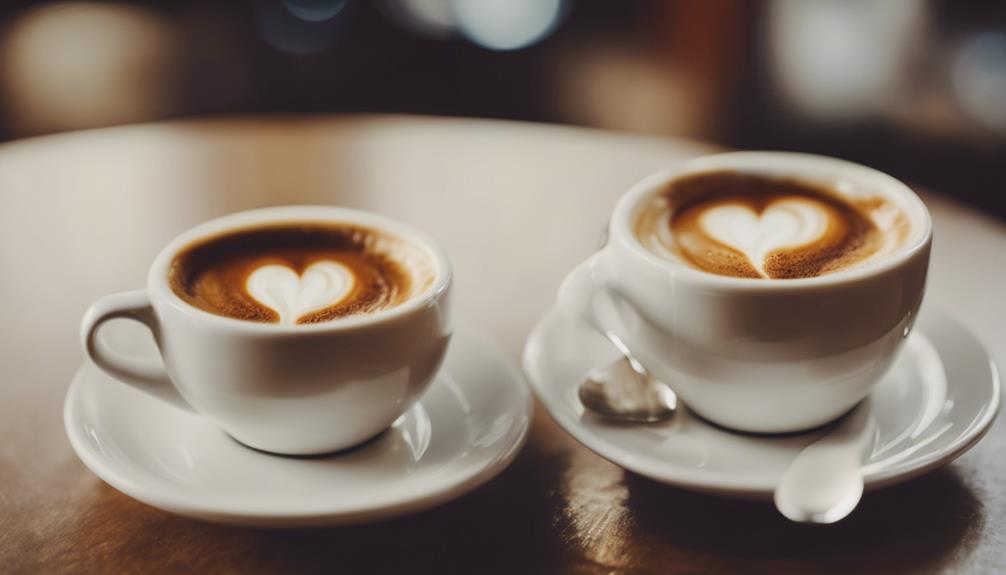
Espresso roasts often exhibit higher levels of bitterness compared to regular coffee roasts due to their darker profile and concentrated brewing process. The darkness of espresso roasts, achieved through longer roasting times, can intensify the perception of bitterness in the final brew.
When hot water is forced through finely-ground espresso beans under high pressure, it extracts a higher concentration of oils and compounds, which can contribute to a more pronounced bitter taste in espresso drinks.
The concentrated nature of espresso, with its small serving size, can also play a role in elevating the bitterness levels. Despite the inherent bitterness in espresso roasts, skilled baristas often blend beans to create a balanced flavor profile, aiming to harmonize the boldness with other nuanced tastes.
When properly brewed, espresso can offer a complex sensory experience where bitterness complements rather than overwhelms, providing a rich and satisfying flavor profile for coffee enthusiasts to enjoy.
Bitterness: Espresso Vs Drip Coffee
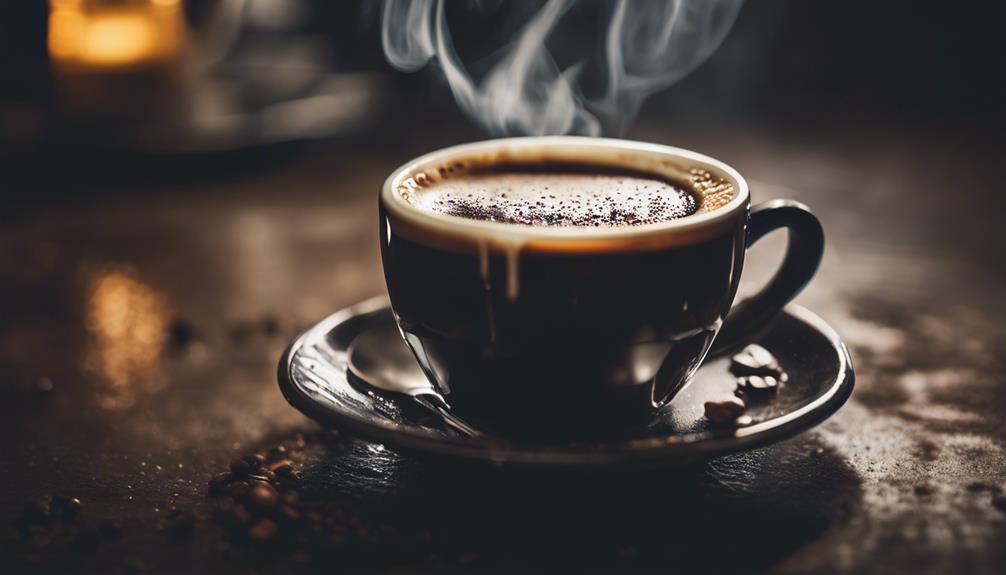
For a comparison of bitterness between espresso and drip coffee, consider the brewing methods' impact on flavor intensity and taste profile. When evaluating bitterness levels, espresso tends to be less bitter than drip coffee due to the following reasons:
- Significant: Espresso's quick extraction process results in a less bitter taste compared to the longer brewing time of drip coffee.
- Essential: The high-end pressure used in espresso brewing enhances sweetness and reduces bitterness, contributing to a smoother flavor profile.
- Critical: Espresso's fine grind size allows for a rapid extraction, minimizing the risk of over-extraction and bitterness often found in drip coffee.
These factors play a critical role in why espresso is often perceived as less bitter and more flavorful than drip coffee, making it a preferred choice for those seeking a high-end coffee experience with a smoother taste profile.
Frequently Asked Questions
Which Is More Bitter Coffee or Espresso?
Espresso and coffee differ in bitterness levels, with espresso generally less bitter due to its concentrated nature and shorter brewing time. The quick extraction process of espresso results in a smoother taste compared to drip coffee.
While espresso beans may be darker roasted, balancing bitterness, careful brewing control minimizes bitterness. Though crema can add slight bitterness, espresso's overall intensity of bitterness usually falls below that of regular coffee.
Which Coffee Is the Least Bitter?
When looking for the least bitter coffee, consider lighter roasts like Ethiopian Yirgacheffe or Costa Rican Tarrazu.
Cold brew coffee, due to its cold water steeping method, often offers a smoother taste.
Specialty coffees from regions such as Panama or Kenya provide unique flavors with low bitterness.
Some blends marketed as 'low acidity' or 'smooth' may also be less bitter.
Experimenting with brewing techniques like French Press or adjusting water temperature can help reduce bitterness in your coffee.
Does Espresso Taste Better Than Coffee?
Espresso has a distinct taste that many prefer over regular coffee. Its rich, bold flavor often captivates coffee enthusiasts.
The quick extraction process results in a smoother, less bitter profile compared to drip coffee. The concentrated nature of espresso brings out a range of flavors without overwhelming bitterness.
This unique brewing method allows for a well-balanced extraction, enhancing the overall taste experience for those who enjoy a robust yet less bitter cup.
Is Espresso Just Stronger Coffee?
Espresso isn't just stronger coffee; it's a concentrated form made by forcing hot water through finely-ground beans under pressure. This process extracts flavors differently from regular coffee, resulting in a more intense taste profile.
While espresso can be strong, it's not necessarily more bitter if brewed correctly. Its bitterness is often balanced with other flavors like sweetness, acidity, and richness, offering a unique sensory experience with fruity, nutty, and chocolatey notes.
Is Espresso a Less Bitter Option Compared to Black Coffee?
When it comes to espresso vs black coffee differences, one key factor to consider is bitterness. While both drinks can have a bitter taste, espresso is generally considered to be more intense and less bitter compared to black coffee. This is due to the higher concentration of coffee and shorter extraction time in the espresso-making process.
Is Blonde Espresso Less Bitter Than Regular Espresso?
Blonde espresso caffeine content may be slightly lower compared to regular espresso, resulting in a milder flavor. The lighter roast of blonde espresso helps to minimize the bitter taste often found in darker roasts. This makes blonde espresso a great option for those looking for a smoother, less bitter coffee experience.
Conclusion
To sum up, while both espresso and coffee can have bitter notes, espresso is typically less bitter due to its concentrated brewing process.
Factors such as grind size, brewing time, and roast level all play a role in the perceived bitterness of the final cup.
By understanding these factors and experimenting with different brewing techniques, you can tailor your espresso experience to your taste preferences.
Remember, the key to enjoying espresso lies in finding the perfect balance of flavors.

